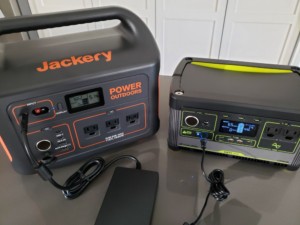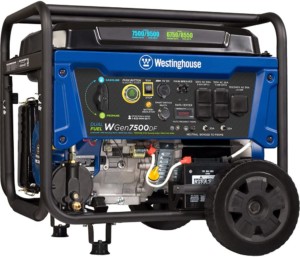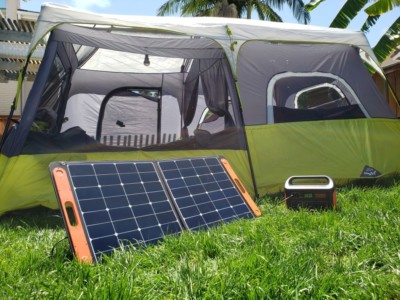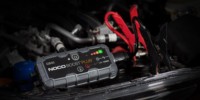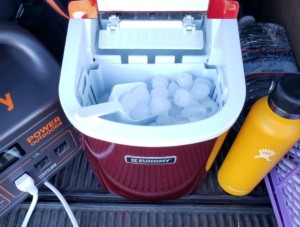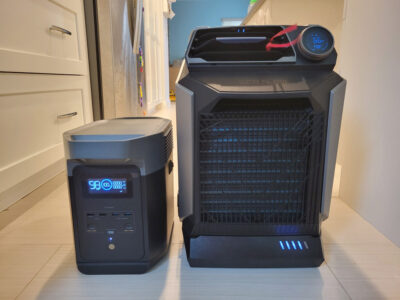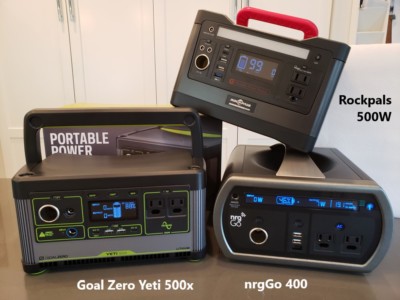Contents
Need for Power
In an emergency, we could find ourselves stranded with no electricity in a World that is consuming much more power today than ever before. Just in the past year alone, the globe was hit with numerous fires, earthquakes, hurricanes, tornadoes, tsunamis, and even riots! Solar panels were installed in our home earlier this year during the COVID-19 pandemic that resulted in grid power staying shut for nearly the entire day while the family had to work from home and do distance learning. Then there was a time when my son and I went backpacking in the Sierra Wilderness after camping out in 106F degree heat the night before, kept cool by a small fan and ice making machine.
Generators vs Battery Power Stations
There are numerous ways that electricity can be produced for businesses, emergencies, or recreational use. This article will go over the most popular ones: gas/ propane generators and lithium-ion battery power stations. Which one is best for you? It depends on your needs.
I am personally not a fan of gas or propane generators, but there are many advantages they have over battery power stations. Across my extended family’s homes, we have a Goal Zero Yeti 1500x, EcoFlow Delta Pro, and Jackery Explorer 1000 lithium-ion battery power stations, and my dad has a Honda EU2200i (1800W – 2200W) gas generator. I use my batteries for camping and road trips, and my dad uses his Honda to run a portable air conditioner during a power outage in 105F degree weather.
Goal Zero, EcoFlow, Bluetti, and Jackery are the leading brands in battery power stations.
Where generators create electricity using a fuel source, such as gasoline or propane, battery power stations store energy obtained from AC outlets, solar panels, and even generators. The key for power stations is that they store electricity, but marketers misleadingly refer to them as battery or solar “generators”.
Power Output
It is important to understand the difference between Watts and Watt-Hours. How much power is used or produced is measured in Watts, and how much energy a battery can store is calculated in Watt-Hours.
- The higher the Wattage, the more electric devices can be powered. A typical RV, for example, uses an average of 3,000W, whereas a laptop may only need 80W
- The higher the Watt Hours (applicable to batteries only), the longer the electric devices can stay running
A gas, propane, or battery power station may, for instance, output 1,000W of power, and a battery may be able to store 2,000 Wh of energy used to output that 1,000W.
Example: Goal Zero Yeti 500x has a battery capacity of 500 Wh and outputs 300W continuously. If it outputs 300W at all times, it would run out of power after 1.67 hours (500 Wh / 300W).
With all three sources of energy, you will usually find the “rated” and “surge” wattage. What are the differences?
Rated vs Surge Wattage
Electronic devices always start at a higher wattage than when they are already turned on and running. For example, a miter saw can use 2,100W when turned on (surge), but once it is running, it only uses 800W (rated). In short, the rated wattage is when the appliance is already running, and the surge occurs upon power on.
Rated is also known as running or continuous, and surge can also be referred to as starting or peak wattage.
Let’s use the Goal Zero Yeti 500x battery to illustrate the difference. It is rated for 300W with a peak of 1,200W.
Running Power (Rated)
- A TV that uses 100W can be used with the Yeti 500x because it consumes less than 300W
- Up to 200W more devices can be added for as long as they do not exceed 300W combined. You could, for example, connect two more 100W televisions
- An 800W miter saw, on the other hand, because it exceeds 300W, cannot be used. The battery will not be able to produce more than 300W continuously
Starting Power (Surge)
A generator or power station’s surge rating allows it to temporarily accommodate a device up to that level for a very short amount of time — usually for just a few seconds.
- A gaming computer may use 290W with a maximum of 600W during power-on or intense gaming
- Its starting power is 600W and below the Yeti 500x’s 1,200W peak. It is able to be turned on
- Once powered on, the computer then runs at a continuous 290W. Because this is within the Yeti 500x’s rated 300W, it is able to stay on
Warning: Some batteries are so well-designed, they can run devices at higher than the rated wattage for a longer period of time, but that can severely shorten the lifespan of the battery. You should always try to stay at or below the rated capacity of a generator or battery.
Operating Cost
Generators have a lower, initial cost of investment: they are far less expensive to purchase for the same amount of power put out by batteries. The 7,500W Westinghouse Wgen7500DF dual-fuel generator, for example, costs $1,060, whereas a 2,000W Goal Zero Yeti 3000x costs $3,200 and the 2,000W Goal Zero Yeti 6000x goes for a whopping $5,000!
On the flip side, generators will require a lot of maintenance over batteries, and so the cost saved at the beginning may add up more over the long run in maintenance expenses.
Gas vs Propane Generators
PROS for Gasoline over Propane
- Gas is more easily available since gas stations are everywhere
- More efficient energy production
- Higher BTU (heat) production per gallon of fuel (by about 30%), making gas cheaper to operate than propane
- Less expensive to own
- Smaller, more portable
- Most popular type of generator
- More reliable in cold climates (propane tank regulators are susceptible to freezing)
- Usually have on-board fuel tanks (Propane tends to be in exterior tanks)
CONS against Gasoline over Propane
- Highly flammable and riskier to store near a home
- Louder than propane generators
- Dirtier-burning than propane
- Worse for the environment and more harmful to humans and pets
- Worse for generator’s lifespan due to a higher release amount of toxins and carbon deposits in the engine
- Gas has shorter shelf life than propane (degrades after about 1 year)
- Even if not used, gas needs to be replaced every so often (every 6 months)
- Propane does not expire, but the propane tank does at around 12 years
- In a disaster, gas stations may cease operation, and you would be out of gas
- Gas is higher in demand during emergencies
- Propane is stored in cylinders that can last and be stored for a long time near your home
Gas Generators vs Battery Power Stations
PROS for Gasoline over Battery
- Can run virtually forever for as long as fuel is available
- Battery power stations will eventually run out. They can be recharged via solar panels, but that will depend on sun availability
- Longer shelf life than batteries
- Lithium-ion Batteries
- Nickel Manganese Cobalt (NMC) has a lifespan of 500 cycles. It will continue to operate past that, but efficiency will start to degrade by about 20% for every 500 cycles
- Lithium Iron Phosphate (LiFePO4) can have as high as 4,000 cycles (as of 2023) lasting 10+ years, such as the EcoFlow Delta Pro
- Lithium-ion Batteries
- Much cheaper upfront than batteries, but maintenance cost may negate that over time
Goal Zero, EcoFlow, Bluetti, and Jackery are the leading brands in battery power stations. LiFePO4 batteries are less volatile (safer), more usable in extreme temperatures, and have a higher charge cycle count (battery lifetime) than NMC.
CONS against Gasoline over Battery
- Should NEVER be operated indoor or in partially-enclosed areas (even with ventilation)
- Carbon monoxide gets generated and can kill you
- Must be kept at least 3′ from any structure during use
- Battery power stations can be used anywhere, even inside or next to a house (or car!)
- Fuel is highly flammable, toxic, and bad for the environment and your health
- Fuel is continuously consumed even if no power is needed by any plugged-in devices
- A battery power station only outputs the amount of power that connected devices require. If nothing is needed, the battery sits there idle with little to no loss of power
- Runs louder (battery stations run nearly silent and can be used throughout the night at camp sites)
- Cannot be used past a certain time at camp sites (usually 10pm)
- Some generators operate fairly quietly at 59 dB, such as the Champion 3400W Dual-Fuel
- Constant maintenance required (ie. changing of fuel every 3-6 months)
- Gasoline may not be available during emergencies
- Gas stations tend to run out fast during those times. Batteries, however, can be recharged via solar panels, such as the Goal Zero Nomad 200 and Jackery SolarSaga 100W
- Not as portable as battery power stations
- Requires more care to transport
- More cumbersome to take on camping trips
Check it out!
Ultimate Reference: Power Station Comparison – We summarized the specifications of many of the power stations we had come across or reviewed all in one place.
Dual-Fuel Generators: Gas AND Propane
There is a breed of generators available that can use both gasoline and propane as their fuel source. This gives you the best of both worlds:
- Option to power by gas or propane (LPG) through a simple switch (usually)
- Flexibility to choose whichever fuel source is available during an emergency (gas stations tend to run out first)
- Propane is safer to store near a home whereas gas is more efficient
- You can choose which fuel type you want to use for the task at hand
- Keep in mind that Propane is less efficient than Gas, outputting less Wattage
- Example: Westinghouse WGen7500DF Dual-Fuel
- With gas: 7,500W running power with surge of 9,500W
- With propane: 6,750W running power with surge of 8,550W
- Example: Westinghouse WGen7500DF Dual-Fuel
- Some generators also include a lithium-ion battery to charge mobile devices without the engine running
Jump Start Car?
Neither a gas/propane generator nor battery power station can be used to jump start a car. Instead, I suggest getting a small, portable one specifically made for that, such as my favorite: NOCO Genius Boost Car Jump Starter (Lithium Battery).
Tips
To learn about lithium-ion (Li-ion) battery power stations, please refer to my reviews for the excellent, Nickel Manganese Cobalt-based (NMC) Goal Zero Yeti 1500x, Jackery Explorer 1000, and Goal Zero Yeti 1000 Core power stations. Lithium Iron Phosphate (LiFePO4) batteries are arguably better than NMC, as detailed in these reviews: EcoFlow Delta Pro and BigBlue CellPowa500.
- When my family had solar panels installed onto the roof of our home, our power was shut off for nearly the entire day. We were working from home while our son was participating in distance learning during the COVID-19 pandemic
- The Yeti 500x, Explorer 1000, and a pair of Jackery SolarSaga 100W solar panels provided us with enough power to keep the internet alive while running multiple laptops, monitors, and the 53qt Costway EP24413 / 54qt Foho BCD-52 car freezer with our infant’s precious milk
- A Goal Zero Nomad 200 costs the same as two Jackery SolarSaga 100W
The value of having an alternate source of power is insurmountable in today’s interconnected World filled with conveniences.
Gas Generator Usage
- If you do not know how to use a generator, ask someone who does
- Incorrect usage could cause damage, injury, and/or death to the engine, you, your home and devices, and even your neighbors/utility workers outside!
- Buy fuel in smaller quantities and store in clean containers
- Less chances of all fuel getting contaminated
- Best fuel: unleaded gasoline with less than 10% added ethanol (check your owner’s manual for the best fuel mix to use with your generator)
- Never use E85 fuel. Don’t mix oil with gasoline
- When engine is in use, change its oil after the first 5 hours, then every 50 hours
- Change engine oil every 3-6 months or add a fuel stabilizer
- Gasoline deteriorates after a year and can damage your engine over time if not changed
- Change air filter once a year to maintain efficiency
Gas Generator Safety
- ALWAYS make sure you ground the generator to minimize electrocution risk!
- Use #8 size wire to connect the generator’s Ground Terminal to a ground source (ie. metal underground water pipe that is at least 8’ into the earth)
- Never start/stop engine with electric devices plugged in and turned on
- Be aware that the starter cord can retract rapidly and pull your hand/arm toward the engine faster than you can let go
- Never add fuel while the engine is hot or running as it could ignite
- Do not overfill the fuel tank so the fuel can expand
- Overflowing fuel can ignite when spilled against the hot engine
- Do not store fuel in the house as they are highly flammable
- You should not smoke near it
- Fuel in the engine’s tank degrades over time. It should be replaced every 6 months even if it was never used
- Never plug the generator into a wall outlet to “back feed” electricity into the house to power your appliances
- This is EXTREMELY DANGEROUS and can electrocute utility workers and neighbors served by the same utility transformer
- To power appliances in the house, have a licensed electrician install the right equipment for the generator to be plugged in to! THIS IS IMPORTANT!
- Never cover the generator when in use to minimize overheating
- Generator should be used on a level surface
- Don’t use in wet/damp conditions (ie. rain) as you could get electrocuted
CAUTION: Never plug a gas or propane generator into a wall outlet to power the house. This is considered “back feeding” and can electrocute utility workers and neighbors saved by the same utility transformer. A licensed electrician should install the proper equipment for the generator to be plugged in to
Calculations
The below calculations are rough estimates as conditions, quality, and product age can vary.
How many Watts does a device use?
- Calc: Watts used by device = Voltage x Amperage
- If a vacuum is 120V and 9.5A, it uses 1,140W
How long does it take to charge a device?
- Calc: Hours to charge device = Device’s battery capacity (Wh) / Input Wattage
- If a laptop accepts 60W of input and its battery capacity is 550 Wh, it could take 9.2 hrs to charge (550 Wh / 60W)
Portable Air Conditioner
The EcoFlow Wave is a portable air conditioner that accepts both AC and DC input. The company, of course, recommends using its own Delta power stations for better efficiency and longer runtime because they can draw directly from DC power. In a pinch, any battery or generator capable of providing the Wave-required input wattage could be used, but keep in mind that AC power loses some energy due to conversion to DC.
Summary
A gas/propane generator is significantly cheaper than any Nickel Manganese Cobalt (NMC) or Lithium Iron Phosphate (LiFePO4) — both Lithium-Ion — battery power station I could find for the same amount of rated output. It provides for a much lower, initial investment for emergency operation, but one should keep in mind the overall maintenance work and cost that comes with gas and/or propane generator use (less so with the latter). With a high amount of output, such as 9,000W, an entire house could be powered with the proper, electrical equipment installed by a licensed technician. Dual-Fuel generators also provide the ability to choose between gas or propane for added versatility when one fuel source is not available during an emergency situation. Furthermore, as long as gasoline or propane is readily available (which they may not be during an emergency), the generator can virtually run forever with proper maintenance.
My camping needs point me towards NMC or LiFePO4 portable battery stations. I prefer them because they are very small and light, run silently without any toxic fumes, and can be operated indoors (like cars and tents). Recall that battery power stations do not generate electricity, but rather just store them. As such, once the battery is out, it is out. You may add solar panels to keep them charged, but unlike gas and propane generators, those panels will only work effectively when the sun is out.
The best source of electricity — as stated at the beginning — will depend entirely on what your needs are.
Where To Buy
- Battery Power Stations with Solar Charging capability
- Gas Generators
- Dual-Fuel Generators (Gas, Propane)
- Westinghouse Wgen7500DF / Champion 3400W
- Solar Panels
- NOCO Genius Boost Car Jump Starter (See our Review)
Related Posts
- Reviews
- Battery Power Stations
- Goal Zero Yeti 1500x / 1000x / 500x
- Jackery Explorer 1000 / 300
- EcoFlow Delta Pro LiFePO4
- Bluetti EB70S LiFePO4
- BigBlue Cellpowa500 LiFePO4
- Rockpals 500W / nrgGo 400
- Solar Panels
- Goal Zero Nomad 200 / Jackery SolarSaga 100W
- Battery Power Stations
- EcoFlow Wave Portable Air Conditioner
- Quick Look
- Announcements
Other Useful Topics
Battery Technology and Safety
Goal Zero debuted with Lead-Acid batteries that were bulky and heavy. Today’s devices use Lithium-ion — commonly Nickel Manganese Cobalt (NCM) or Lithium Iron Phosphate (LiFePO4 / LFP) chemistries — for more power in a smaller, lighter package. NMC, however, is more volatile than LiFePO4 and becomes riskier as more cells are packed together. Goal Zero and Jackery used NMC for some time whereas EcoFlow and Bluetti use LiFePO4. Jackery launched its first LiFePO4 model in mid-June 2023 and Goal Zero in October that year.
- How much energy a battery can store is measured in Wh (Watt-hours), and how much power is used or produced in W (Watts)
- The higher the Watt-hour (Wh) capacity rating, the more dangerous the battery could become if not handled right
The quality of the battery cells and the BMS (Battery Management System) are crucial for safety.
Cell Manufacturers
Battery cells made by LG and Sony are among the best in the hobbyist world as are Sanyo/Panasonic and Samsung. Goal Zero uses LG. Jackery also uses LG or BAK (a leading Chinese brand). EcoFlow makes its own. During my years of research, I found that use of lower-quality batteries could pose a serious risk to life and property and should become a crucial part in deciding what to buy.
Safety
The second part in a battery’s safe operation depends heavily on the design and BMS (Battery Management System). Some BMS manufacturers, unfortunately, overstate their capabilities that could lead to catastrophic failure.
- Design should allow for proper, thermal cooling, use quality components, and obtain proper certifications
- Batteries made by known manufacturers are less likely to fail
- BMS should sufficiently restrict the battery from going past its capabilities



